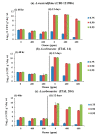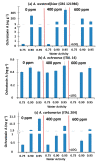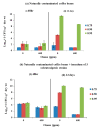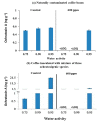Potential Control of Mycotoxigenic Fungi and Ochratoxin A in Stored Coffee Using Gaseous Ozone Treatment
- PMID: 32977688
- PMCID: PMC7598593
- DOI: 10.3390/microorganisms8101462
Potential Control of Mycotoxigenic Fungi and Ochratoxin A in Stored Coffee Using Gaseous Ozone Treatment
Abstract
The objective of this study was to examine the effect of treatment of Arabica green coffee beans with gaseous ozone (O3) for the control of ochratoxigenic fungi and ochratoxin A (OTA) contamination by Aspergillus westerdijkiae, A. ochraceus, and A. carbonarius during storage. Studies included (i) relative control of the populations of each of these three species when inoculated on irradiated green coffee beans of different initial water availabilities using 400 and 600 ppm gaseous O3 treatment for 60 min at a flow rate of 6 L-1 and on OTA contamination after 12 days storage at 30 °C and (ii) effect of 600 ppm O3 treatment on natural populations of green stored coffee beans at 0.75, 0.90, and 0.95 water activity (aw) or with additional inoculum of a mixture of these three ochratoxigenic fungi after treatment and storage for 12 days at 30 °C on fungal populations and OTA contamination. Exposure to 400 and 600 ppm O3 of coffee beans inoculated with the toxigenic species showed that there was less effect on fungal populations at the lowered aw (0.75). However, toxigenic fungal populations significantly increased 48 h after exposure and when stored at 0.90 and 0.95 aw for 12 days. All three species produced high amounts of OTA in both O3 treatments of the wetter coffee beans at 0.90 and 0.95 aw. Gaseous O3 (600 ppm) treatment of naturally contaminated green coffee beans had little effect on fungal populations after treatment, regardless of the initial aw level. However, after storage, there was some reduction (26%) observed in coffee at 0.95 aw. In addition, no fungal populations or OTA contamination occurred in the 0.75 and 0.90 aw treatments after exposure to 600 ppm gaseous O3 and storage for 12 days. It appears that under wetter conditions (≥0.90-95 aw) it is unlikely that fungal populations and OTA contamination of stored coffee beans, even with such high O3 concentrations would be controlled. The results are discussed in the context of potential application of O3 as an intervention system for stored coffee post-fermentation and during medium term storage and transport.
Keywords: Aspergillus section Circumdati; coffee beans; control; intervention; ochratoxin A; ozone treatment; section Nigri; storage.
Conflict of interest statement
The authors declare no conflict of interest.
Figures




Similar articles
-
Isolation, identification and toxigenic potential of ochratoxin A-producing Aspergillus species from coffee beans grown in two regions of Thailand.Int J Food Microbiol. 2008 Dec 10;128(2):197-202. doi: 10.1016/j.ijfoodmicro.2008.08.005. Epub 2008 Aug 22. Int J Food Microbiol. 2008. PMID: 18819720
-
Resilience of Aspergillus westerdijkiae Strains to Interacting Climate-Related Abiotic Factors: Effects on Growth and Ochratoxin A Production on Coffee-Based Medium and in Stored Coffee.Microorganisms. 2020 Aug 20;8(9):1268. doi: 10.3390/microorganisms8091268. Microorganisms. 2020. PMID: 32825420 Free PMC article.
-
Inactivation of A. ochraceus spores and detoxification of ochratoxin A in coffee beans by gamma irradiation.J Food Sci. 2012 Feb;77(2):T44-51. doi: 10.1111/j.1750-3841.2011.02572.x. J Food Sci. 2012. PMID: 22339551
-
Effect of processing on ochratoxin A (OTA) content of coffee.Adv Exp Med Biol. 2002;504:189-93. doi: 10.1007/978-1-4615-0629-4_19. Adv Exp Med Biol. 2002. PMID: 11922086 Review.
-
Research on the origin, and on the impact of post-harvest handling and manufacturing on the presence of ochratoxin A in coffee.Food Addit Contam. 2002 Jul;19(7):655-65. doi: 10.1080/02652030110113816. Food Addit Contam. 2002. PMID: 12113660 Review.
Cited by
-
Impacts of Gaseous Ozone (O3) on Germination, Mycelial Growth, and Aflatoxin B1 Production In Vitro and In Situ Contamination of Stored Pistachio Nuts.Toxins (Basel). 2022 Jun 17;14(6):416. doi: 10.3390/toxins14060416. Toxins (Basel). 2022. PMID: 35737077 Free PMC article.
-
Enhancing postharvest food safety: the essential role of non-thermal technologies in combating fungal contamination and mycotoxins.Front Microbiol. 2025 Mar 11;16:1543716. doi: 10.3389/fmicb.2025.1543716. eCollection 2025. Front Microbiol. 2025. PMID: 40135060 Free PMC article. Review.
-
Ozonized Water in Microbial Control: Analysis of the Stability, In Vitro Biocidal Potential, and Cytotoxicity.Biology (Basel). 2021 Jun 12;10(6):525. doi: 10.3390/biology10060525. Biology (Basel). 2021. PMID: 34204772 Free PMC article.
-
Responses of Phyllosphere Microbiome to Ozone Stress: Abundance, Community Compositions and Functions.Microorganisms. 2022 Mar 22;10(4):680. doi: 10.3390/microorganisms10040680. Microorganisms. 2022. PMID: 35456732 Free PMC article.
-
Special Issue: Coffee, Fungi, Mycotoxins, and Climate Change.Microorganisms. 2023 Apr 4;11(4):941. doi: 10.3390/microorganisms11040941. Microorganisms. 2023. PMID: 37110364 Free PMC article.
References
-
- United States Food and Drug Administration . Code of Federal Regulations: Maximum Acceptable Level of Ozone. Volume 8. United States Food and Drug Administration; Silver Spring, MD, USA: 2019. [(accessed on 31 August 2020)]. 21CFR801.415. Available online: https://www.accessdata.fda.gov/scripts/cdrh/cfdocs/cfcfr/cfrsearch.cfm?f....
-
- Frampton M.W., Pietropaoli A., Dentler M., Chalupa D., Little E.L., Stewart J., Frasier L., Oakes D., Wiltshire J., Vora R., et al. Cardiovascular effects of ozone in healthy subjects with and without deletion of glutathione-S-transferase M1. Inhal. Toxicol. 2015;27:113–119. doi: 10.3109/08958378.2014.996272. - DOI - PMC - PubMed
-
- Suslow T.V. Ozone applications for postharvest disinfection of edible horticultural crops. ANS Publ. 2004;8133:1–8.
LinkOut - more resources
Full Text Sources

